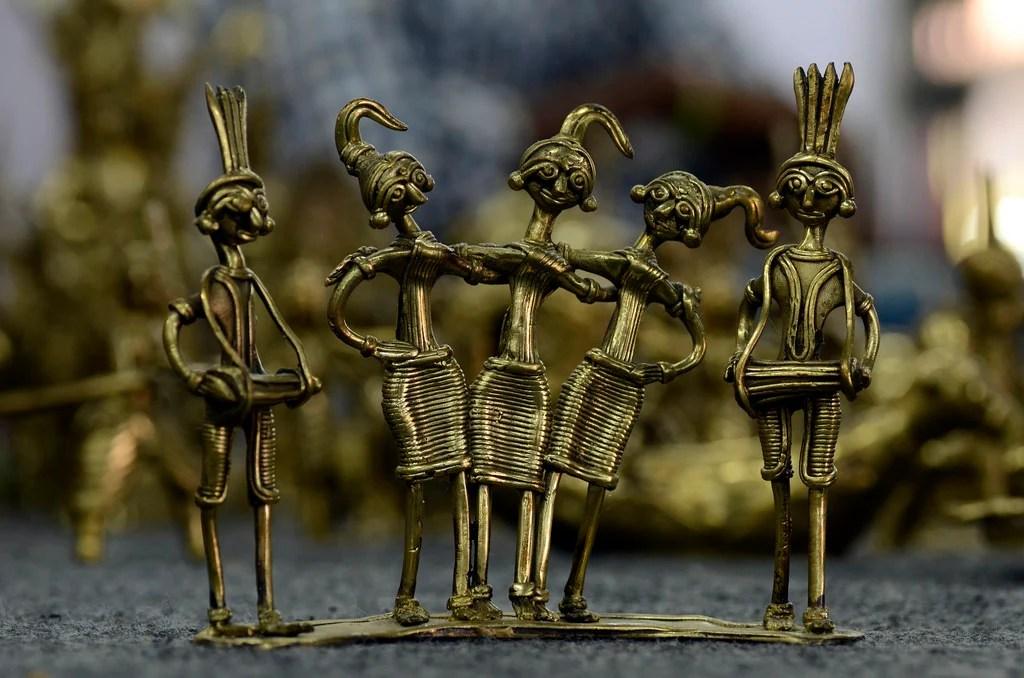Dhokra art is the earliest known method of non-ferrous metal casting known to human civilization. The name Dhokra or Dokra was initially used to indicate a group of nomadic craftsmen, and is now generically applied to a variety of beautifully shaped and decorated brassware products created by the lost wax process. In India, these craftsmen are clustered in the states of Madhya Pradesh, Bihar, Odisha, and West Bengal. Dhokra art is practiced by different communities like the Situlias, Ghantaras, Thataries, Ghasis, Bathudis and other professional Dhokra workers.

Dhokra Products
Dhokra in a nutshell
The Dhokras use lost-wax process to cast hollow brass objects and images. A replica of the desired product is made with wax on a clay core, with all its finer details of designs and decorations. Brass scrap in generally used as raw material. Crafted out of metal through indigenous methods, the distinctive design and form of Dhokra craft reflects the inherent expression of their feelings. It was used for making everything from jewellery to vessels to images of gods, goddesses, animals and birds. The Dhokra craftsmen went from tribe to tribe making their ceremonial and religious figures, ornaments and kitchenware.
This sort of metal casting has been used in India for over 4,000 years and is still used. One of the earliest known lost wax artefacts is the dancing girl of Mohenjo-daro. The product of dhokra artisans are in great demand in domestic and foreign markets because of primitive simplicity, enchanting folk motifs and forceful form. What’s more, the lost wax technique for casting of copper based alloys has also been found in China, Egypt, Malaysia, Nigeria, Central America, and other places.

Dancing Girl (Mohenjo Daro 2500 BC) – Made from bronze, it is one of the rarest artefacts world-over
National Museum, New Delhi
Meet the Dhokras
Dhokra Damar tribes are the traditional metal-smiths of West Bengal. Their technique of lost wax casting is named after their tribe, hence Dhokra metal casting. The tribe extends from Jharkhand to West Bengal, and Odisha; members are distant cousins of the Chhattisgarh Dhokras. A few hundred years ago, the Dhokras of Central and Eastern India travelled south as far as Kerala and north as far as Rajasthan and hence are now found all over India.

The Dhokra Damar Tribe
Dhokra-ing at a glance
There are two main processes of lost wax casting: solid casting and hollow casting. While the former is predominant in the southern parts of India, the latter is more common in Central and Eastern India. Solid casting does not use a clay core but instead a solid piece of wax to create the mould; hollow casting is the more traditional method and uses the clay core.
The first task in the lost wax hollow casting process consists of developing a clay core which is roughly the shape of the final cast image. Next, the clay core is covered by a layer of wax composed of pure bee’s wax, resin from the tree Damara orientalis, and nut oil. The wax is then shaped and carved in all its finer details of design and decorations. It is then covered with layers of clay, which takes the negative form of the wax on the inside, thus becoming a mould for the metal that will be poured inside it. Drain ducts are left for the wax, which melts away when the clay is cooked. The wax is then replaced by the molten metal, often using brass scrap as basic raw material. The liquid metal poured in hardens between the core and the inner surface of the mould. The metal fills the mould and takes the same shape as the wax. The outer layer of clay is then chipped off and the metal icon is polished and finished as desired.
Deconstructing Dhokra
The process of making Dhokra is fascinating and uses only natural raw materials. The basic mould is made with fine sand (mostly found next to the river banks) and clay. Goat and cow dung or husk is added to the principal material, which is then layered with pure beeswax found in the jungle where the craftsmen reside. Wax threads are then prepared and wound around the clay mould until its entire surface is covered uniformly. After this, decorative aspects are added.
Next, the clay is cooked over a furnace while the wax is drained via ducts. The furnace is built above ground with bricks and natural fuel (charcoal, cow dung or coal). The wax burns in the furnace leaving a free channel for the metal to flow. Molten metal (mainly brass and bronze) is poured inside the mould. The moulds are taken out after the metal has melted, and water is sprinkled to cool them. They are then broken and the cast figures are removed. The portions are retouched and are meticulously scoured at the river with clean sand to give the products a soft polished look. Normally, a simple figurine could take anywhere between over fifteen to thirty days to make.
Note: To browse through all the posts in the ‘Handmade in India’ series, click here.

